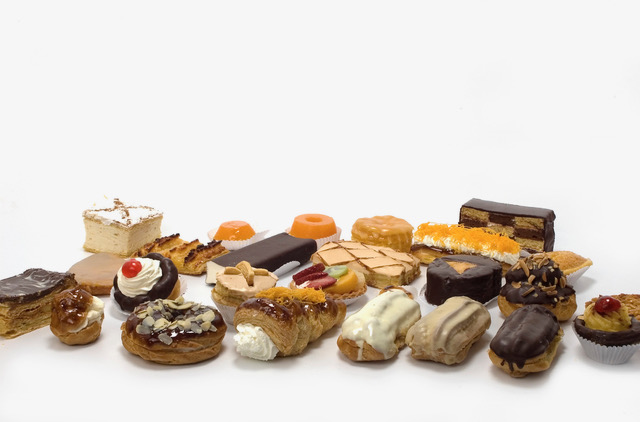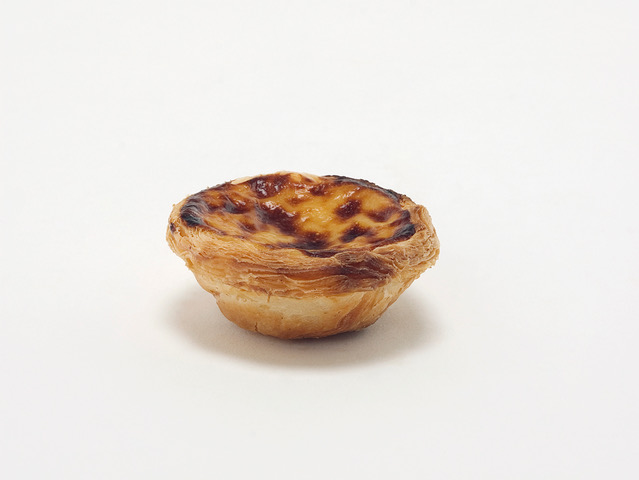
The everyday challenges of Portuguese semi-industrial confectionery
In 2005 Rita João, Pedro Ferreira and I began researching the design of semi-industrial Portuguese confectionery, a term we coined to characterise the kind of one-portion, sweet pastries and cakes sold across Portugal as “Fabrico Próprio.” Meaning “Own Production,” this expression describes baked goods made on the premises of padarias (bakeries) and pastelarias/confeitarias (confectioners or pastry makers). These often double up as cafés or as “snack bars”, a foreign phrase that some time in the 20th century also became associated with establishments serving coffee, confectionery and more or less elaborate meals. The social, cultural and economic flows that make these places a staple of Portuguese society, as well as the connections between design practice, cultures of consumption and paradigms of industrialisation, have since been research interests of mine as a design critic, curator and researcher.
In the 332-page book where we consolidated our research – first edition launched in 2008, second in 2012 – we argued for semi-industrial as a manufacturing paradigm worth examining. We synthesised our approach in one sentence: these cakes are not made by machines; they are made with machines. Instead of being mass-produced, they are manufactured in sufficient numbers to fill Portugal’s many counters every morning. They are also not local or regional: some recipes or ingredients may refer to a particular location, such as a convent, monastery, or royal palace, while others may be connected to the marketing efforts of certain local entrepreneurs. We see these cakes as manifestations of a national culinary culture, which incorporates external ingredients and formats – from the candied fruits and nuts that refer to Islamic or Sephardic Jewish tradition to the more modern renditions of the Croissant, for example. For us, the daily project of this kind of confectionery may be simpler than the rich tradition of Portuguese cuisine and gastronomy, yet it remains more valuable and authentic than any synthetic product promoted by the food industry.
Cakes
Photo: Soraya Vasconcelos
The daily filling of pastelaria counters with often 10 or more unique varieties and respective variations of these cakes – for example, the Caracol [Snail], Ferradura [Horseshoe], Argentino [Argentinian], Trança [Braid], Orelha [Ear], Moinho [Windmill] and Trinitá are all formal variations of the same base of brioche pastry, candied fruits and occasional egg cream – is how a plethora of small, often family-run economic agents respond to specific local demands with a selection of inexpensive, unsophisticated products unbound from local traditions and religious rituals. By allowing for plenty of variation and innovation in both ingredient combinations and formal configurations, this disseminated production has fostered a culinary culture where creativity trumps orthodoxy. Consider the Croissant: whereas in France makers and consumers aim at perfecting responses to the appeal “croissant au beurre il n’y a rien de meilleur”, in Portugal this Austro-French creation is popularly bastardised in puff pastry or brioche versions, stuffed with egg cream or filled with ham and cheese.
Fabrico Próprio has thrived in Portugal as a paradigm of industrialisation, a culture of consumption and an expression of popular culture thanks to many factors. These include the introduction of industrial ingredients, such as margarine, which is used at the semi-industrial scale as the base ingredient of puff pastry and brioche. Agro-industrial multinations such as Unilever – one of the world’s largest margarine (and soap) manufacturers – have exerted since the 1960s a crucial influence over the training of Portuguese bakers, the standardisation of recipes and, above all, the homogenisation of national taste. An offer of increasingly qualified, yet persistently cheap labour has kept product prices consistently low. The peculiarities of a business model created by Delta (Portugal’s largest coffee supplier), which incentivises establishment owners to acquire branded furniture, tableware and other functional or decorative items, has effectively discouraged investing in branding, interior design and promotion. This has given consumers the cheapest espresso in Europe but also undermined the value attributed to the design of, and care for, the country’s foremost public spaces.
Two critical challenges
During the past 15 years, we witnessed some critical challenges to the Fabrico Próprio universe, two of which deserve attention for their upending of the semi-industrial paradigm. The first is the creation or consolidation of bakery and pastelaria chains on a local and national level. Backed by corporate investors or large retail and distribution conglomerates, chains such as A Padaria Portuguesa, Jeronymo and Bagga have become key players in this field. Their sophisticated approaches to branding, store interiors and promotion, investment in product development and reliance on increasingly centralised production, synthetic ingredients and industrial processes express a divergence between Fabrico Próprio’s consumption culture and semi-industrial production.
Pastel de Nata
Photo: Soraya Vasconcelos
The other critical change concerns the creation of a Pastel de Nata monoculture: once just one among many other Fabrico Próprio cakes, the Pastel de Nata or custard tart has become the unchallenged leader of Portuguese pastry and a national icon. Indeed, associations between this cake and expressions of national identity have taken place much beyond the gastronomical public sphere. Especially after the touristic boom of the 2010s, during which the Portuguese witnessed an often-opportunistic exacerbation – or indeed fabrication – of national symbols (such as the sardine), traditions (such as drinking Ginjinha sour cherry liqueur in a chocolate cup) and dishes (such as the Francesinha sandwich). Such associations have influenced the (re)branding, positioning and product offerings at existing Fabrico Próprio establishments, but also grounded the creation of new chains of pastelarias dedicated solely to Pastel de Nata. These include the five brands operating in downtown Lisbon in early 2020 – Manteigaria Nacional, NATA Lisboa, A Nata de Lisboa, Fábrica da Nata and Nataria Nacional – under a very different model of local supply and demand from the one defined by the semi-industrial paradigm.
These brands’ trivial use of the term “artisanal” and in-store, open-kitchen production displays are also quintessential manifestations of what the anthropologist Arjun Appadurai calls, in his landmark book ‘Modernity at Large: Cultural Dimensions of Globalization,’ production fetishism. Where the idiom and spectacle of the local masks translocal capital and transnational earning flows, the idea of locality, which Appadurai interprets as referring to a local factory or site of production, but also, to the nation-state in an extended sense, becomes a fetish that disguises what he calls the globally dispersed forces that actually drive the production process.
With the radical retraction of tourism due to the covid-19 pandemic, this model may reveal to be – much like any other monoculture – both unsustainable and undesirable. These are only two of the current challenges to Portuguese semi-industrial confectionery that Rita João and I have just begun to explore in our research for Fabrico Próprio’s forthcoming third edition. Through a design lens, we aim to better understand and discuss how our nationwide pastry obsession is kept alive. Every single day.
Frederico Duarte (Lisbon, 1979) studied communication design and worked as a graphic designer in Portugal, Malaysia and Italy. He holds an MFA in design criticism from the School of Visual Arts and a Ph.D. in design curating from Birkbeck College, University of London. As a design writer, critic and curator he has written articles and essays, contributed and edited books and catalogues, given lectures and workshops, organised events and curated exhibitions on design, architecture and creativity since 2006. He is currently an assistant guest lecturer in the Communication Design department of the University of Lisbon’s Faculty of Fine Arts.



0 Comments